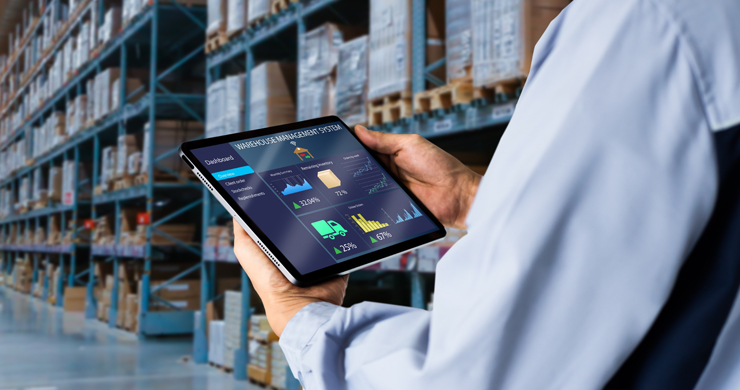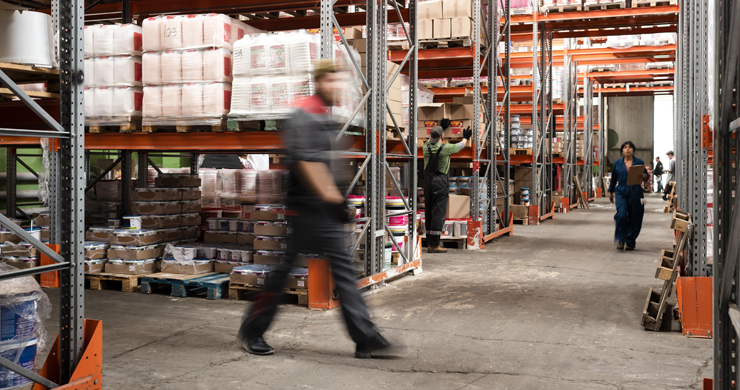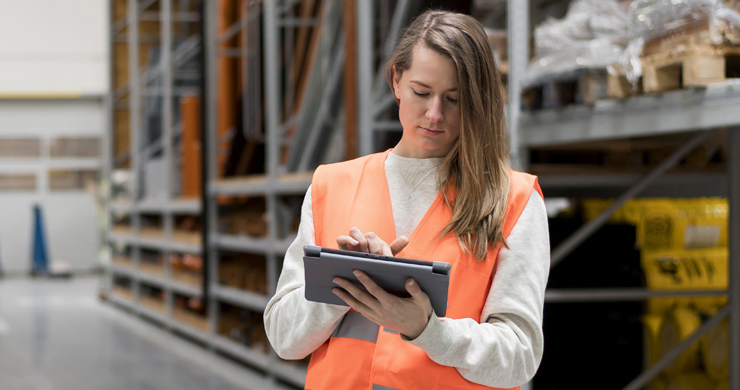Article written by:
Felipe Rebollo Gómez
Head of Business Development and Sales for InLOG Consulting and Devol RPA
.
Tomás Muñoz Alonso
CEO Tomec Engineering
Published by Interempresas on december 13th, 2023.
Digital technology has transformed us. It has also transformed our environment. It is present in all areas of our lives and has given a definitive boost to logistics, expanding its area of action and allowing the development of new business models and leadership in new economic sectors, such as e-commerce. We review the challenges of logistics and its evolution over the past 30 years, looking ahead, a land of opportunity.
.
Goodbye logistics, hello business!
As time goes by and the evolution of the socio-economic reality, a consequence of advances in digital technology, have shown that the logistics function in organizations goes far beyond the traditional management of the finished product warehouse or the mere organization of transportation for deliveries to the customer. For example, the COVID-19 pandemic has taught us its importance in terms much closer to the business. Its economic impact on overall business performance is fundamental, supported, moreover, by digital technologies.
The key to this change of approach, which also goes beyond the boundaries of the supply chain as a global value chain, is the 360° view. To do this, we need business glasses. It is not just a matter of looking at the outer perimeter, but we must also look inside the organization. We must extend the focus of the logistics function to the entire business, including the inbound and outbound logistics chain, intra-logistics and the production or service activity itself. Thanks to technology, we can take full advantage of an activity that has a clear impact on the operating account of organizations and do so on the basis of current data, in real time, for better decision making.
The best example can be seen in how, as a result of the pandemic, logistics chains were put to the test, causing economic activity to be maintained in an environment that was impossible to foresee. Optimal transport management so that nothing stands still and costs are reduced is important; a better organization of the warehouse in order to take out many orders is necessary, as well as having order in the storage spaces. Achieving high product turnover is very good, as it is the key to the economic system. Delivering customers their orders on time by informing them in real time of the transport situation is even better. However, all this is no longer enough.
These approaches to the partial optimum, or the particular KPI of a process, may be useful for tracking day-to-day activity, but not for realizing the full potential of value creation for the business, which expanded logistics does make possible. This logistics, the one that creates the most added value, must be understood in real time and throughout its internal and external perimeter, from end to end, that is, from the raw material supplier to the end customer. It is logistics expanded to the entire business. Whether inside or outside the physical facilities (whether they are delivery or distribution centers; final product warehouses or production plants; own or third-party facilities), the important thing is to have the information of the moment, in real time, to make the best global decisions. Esta visión de la logística expandida en tiempo real se sustenta en la idea de que es posible maximizar la eficiencia de todo el conjunto y que esto puede ayudar tanto al tejido empresarial como a la sociedad a avanzar y a ser más competitiva. Expanded logistics can and should help companies, whether productive or not, to develop and grow their businesses by leaving the necessary physical or technological infrastructure (hardware and software) in the hands of specialized companies that accompany them in this conceptual transformation.
Reliance on proven business tools and solutions is key here. Private companies linked to the logistics sector must be able to provide solutions to the needs of customer companies through projects, success stories, references and new functionalities.
The concept of expanded logistics could be formulated as a way to pursue the maximum efficiency of all systems, whether digital or not (facilities and hardware), present or future, inside and outside the customer-companies. All these tools around the customer are just one more way to provide them, in real time, with all the information and services they need, and help the business to make better decisions.
In parallel to this, and over the years, there has been a clear evolution in the consideration of the need to provide sufficient resources to both the logistics function and the technology associated with it, and not only when it comes to having assets (warehouses, equipment that move products, people, specialized training, etc.). Companies are increasingly aware that they must obtain added value by linking the entire value flow inside and outside their facilities, reaching the hybridization of the external with the internal, and of the productive part of the business with traditional logistics. You have to benefit from the whole and forget about cost savings in isolation. It is necessary to provide it with a broader and more global vision, making the best decisions for the business in real time in the ever-growing field of logistics.
To the extent that we make expanded logistics a reality, we will be able to create greater benefit for our customers.
.
More technology to create more value
Digital technology, in its wide range of proposals and solutions, is the magic behind the fact that millions of products cross half the world and end up on our table, in a warehouse or in any physical store or factory. This little everyday miracle that we hardly notice is behind every economic activity: from spare parts to suitcases, books, perfumes, furniture, vehicles and people. All this was science fiction not so many years ago.
Digital technology brings us closer to the world and everything is just a click away. Now all that’s left to do is to get the goods to the customer. The immediacy enabled by digital technology has transformed and given a decisive boost to the growth of the logistics sector.
Thousands of companies around the world, millions of employees and enormous resources make it possible. At the national level, the numbers of the sector are impressive: management of more than 500 million shipments per year, approaching 10% of the GDP and generating employment for more than 1 million people. Digital technology is the miracle worker. Digitization avoids losses of products in storage or in transport, saves rework, improves efficiency and allows 24/24 operation. It is enough to remember that the success in the global market of large e-commerce benchmark companies is fundamentally based on digital technology.
Regarding the benefits of expanded logistics in real time, the most obvious is the digitization of daily tasks: a three-digit increase in productivity compared to traditional warehousing, with non-technological means. Digital technology is what makes all this possible. Let’s think about the detriments of not having digital technology in any sector. It would be impossible to manage those billions of products without it. Without her help, mountains of packages and shipments would pile up. No sector can do without digital solutions in its day-to-day operations. Just think of a service outage, for whatever reason, which, in addition to paralyzing the activity of companies for hours, generates chaos that lasts over time, since the activity never stops.
.
E-commerce as a lever for logistics transformation
Digital technology plays a fundamental role in e-commerce logistics. Technology makes it easier for us to communicate, brings us closer, gives us visibility and helps us to do more things, to train and inform ourselves. Technology, like a tsunami, is omnipresent and unstoppable, forcing us with its evolution to adapt permanently.
There is no doubt that the momentum of e-commerce and its fierce struggle for delivery time differentiation with traditional transportation and logistics has already transformed our lives, not just our cities. Is there anyone out there who is willing to give up the convenience and go back to the long lead times and unknown dates of yesteryear? E-commerce has also transformed the logistics chain forever through its intense and clear commitment to digital technology. It has even led us to reconsider the future and design of our cities and our daily lives. There are different approaches from different large international companies regarding the model that will work best for us. We, customers choosing one or the other platform or Marketplace, determine the future here as well.
Estamos ahora mismo en plena eclosión de distintos esquemas respecto a cómo serán los servicios de entrega en las ciudades. This natural interaction will affect their own future design and especially their mobility. The history of last-mile logistics is only a few years old. Which one will consolidate? Time will determine whether we will serve from large, central remote warehouses, or from smaller, closer locations or even mixed spaces. An example can be seen right now in retail or food, where different proposals coexist: on-line orders are served from hypermarkets with assisted manual picking, which can be picked up by the customer or delivered to the customer’s home from centers near large cities; or within the cities themselves, from traditional supermarkets that also serve the regular customer; or from order preparation centers that do not serve the public but are located at street level.
All these proposals have in common the fundamental premise of immediacy. Winning the unstoppable battle to reduce delivery time in a society that increasingly values time as a fundamental variable. Technology plays a leading role and makes it possible for us to have everything we need, all in real time thanks to the immediacy made possible by technology!
The influence of e-commerce on our cities is evident. And although growth of over 25% in global e-commerce, as has happened in recent years, is difficult to maintain, technology evolves and our environments will have to change and adapt to the times.
.
Logistics 4.0
A first key concept linked to expanded logistics is that it must consider all flows outside and inside the company, with the vision of the business and in real time. If we take a look at the software/hardware solutions linked to respond to the different challenges of expanded logistics in recent years, we see a clear evolution towards specialized products that are standardized but adaptable or based on environments/software that the market adopts as standard at a global level.
30 years ago, for example, logistics software developments (WMS, ERP, CRM…) were custom-made, which posed its own challenges (long duration, uncertainty, cost, etc.) and has given rise to the current opportunities for the development of proprietary logistics solutions for real-time warehouse management: parameterizable, adaptable, with modules to increase their specific functionalities, such as production, integrable with absolutely any tool on the market, etc.
The experience acquired in developing software solutions allows us to identify some of the keys to be taken into account when looking for the characteristics of a WMS (Warehouse Management System) logistics software:
– First of all, no software solution is a solution if it is not in real time, so that the best decisions can be made based on the analysis of current information and data. The more cloud-native, the less latency.
– They must be scalable, accompanying the business and allowing its growth.
– They must be easily integrated with all types of current and future systems (MES, ERP, CRM, API, webservices, etc.) because complete interoperability is not an option in these times of accelerated technological revolution.
– They must incorporate advanced radio frequency equipment with voice-picking, a technology that is becoming increasingly competitive and allows picking operators to increase order picking by more than 40%, as well as reduce the investment in hardware infrastructure required for its implementation.
Regarding the automation or warehouse robotization software, with which the dispensed logistics must necessarily interact, we could give some recommendations such as:
– Strategic approach: Expanded logistics must be approached from a strategic perspective that considers all aspects of the business, from the supply chain to final delivery to the customer. This involves close collaboration between different areas of the company such as production, sales, marketing and customer service. All with the aim of optimizing all logistics processes and generating greater value for the business.
– Systems integration: Expanded logistics requires seamless integration of all technology systems used in the business environment; warehouse management systems (WMS), enterprise resource planning systems (ERP and MRP), customer relationship management systems (CRM), production management and control software (MES), and plant process control systems (Scada, PLCs). These systems must interconnect and share information in real time to ensure complete visibility of all logistics operations and facilitate decision making based on accurate and up-to-date data.
– Automation and robotics: Automation and robotics technology plays a key role in expanded logistics. By using automated systems, such as storage and picking robots, automated conveyors and sorting systems, companies can increase efficiency, reduce processing times and minimize human error. Automation also enables greater flexibility and adaptability to changing market demands. This includes the use of technologies such as artificial intelligence and the Internet of Things (IoT) to improve efficiency in warehouse management, transportation and product delivery. In addition, planning and control systems should be implemented to allow greater coordination and synchronization of all logistics activities. Companies must be open to the adoption of new technologies and logistics practices, as well as to the continuous improvement of their processes and services. This means being aware of trends and developments in automation, digitization and supply chain management, and being ready to implement them to stay competitive in an ever-changing business environment.
– Data analysis and machine learning: Expanded logistics benefits greatly from data analytics and machine learning. By collecting and analyzing large volumes of logistics data, companies can identify patterns, trends and opportunities for improvement. This enables more informed decision making and the implementation of proactive strategies to optimize workflows, reduce costs and improve customer satisfaction.
– Deployment of service-based modalities, thanks to SaaS or RaaS approaches, software solutions are getting closer and closer to the business and solutions are being developed that adapt to the business. The ultimate goal: to make costs and investments as variable as possible and to allow them to fluctuate in line with business realities.
– Collaboration and visibility in the supply chain: Expanded logistics implies greater collaboration and visibility in the supply chain. It is necessary to establish connections and share information with suppliers, logistics partners and customers to have a complete view of all flows and processes. This facilitates decision making based on accurate and up-to-date data, as well as the identification of improvement opportunities and the rapid resolution of problems.
– Personalization and customer experience: Expanded logistics seeks to offer a personalized and satisfactory customer experience. This implies the ability to adapt logistics processes to the needs and preferences of each customer, such as delivery at specific times or product customization. To this end, it is essential to have flexible and agile systems that allow the configuration of logistics services and processes according to the requirements of each customer.
.
Real time expanded logistics to create more value, faster
Companies must necessarily understand real-time expanded logistics as a tool that helps customers’ goal of becoming super-competitive in an era where local and global competition is and will become increasingly fierce. An era in which immediacy will increasingly make the difference.
Innovation and permanent updating of digital solutions are requirements for customers. All of this reinforces your reliance on digital technology. Technology to make expanded logistics a reality that helps your present and future growth, reliable and competitive.
Everything revolves around giving the customer the maximum added value today, tomorrow and always.





